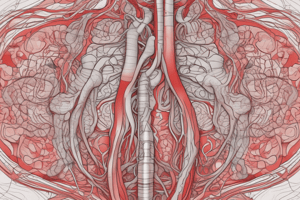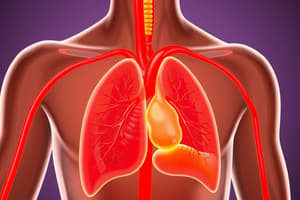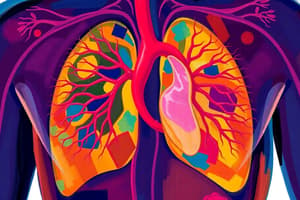Podcast
Questions and Answers
What is the primary function of the pulmonary circulation?
What is the primary function of the pulmonary circulation?
- To transport deoxygenated blood from the heart to the lungs. (correct)
- To supply oxygenated blood to the body.
- To return deoxygenated blood from the body back to the heart.
- To carry oxygenated blood from the heart to the lungs.
Which blood vessel carries oxygenated blood back to the heart from the lungs?
Which blood vessel carries oxygenated blood back to the heart from the lungs?
- Aorta
- Pulmonary vein (correct)
- Vena cava
- Pulmonary artery
What is the role of the aorta in the circulatory system?
What is the role of the aorta in the circulatory system?
- To distribute oxygenated blood to the body through arteries. (correct)
- To carry oxygenated blood from the heart to the lungs.
- To return deoxygenated blood from the body to the heart.
- To transport deoxygenated blood from the heart to the lungs.
Where is the human heart located?
Where is the human heart located?
What are the upper and lower chambers of the heart called?
What are the upper and lower chambers of the heart called?
How does living at altitude enhance an athlete's performance?
How does living at altitude enhance an athlete's performance?
What is the primary function of leukocytes?
What is the primary function of leukocytes?
Which type of leukocyte is responsible for engulfing harmful microbes?
Which type of leukocyte is responsible for engulfing harmful microbes?
What role do antibodies serve in the immune response?
What role do antibodies serve in the immune response?
What constitutes platelets in the blood?
What constitutes platelets in the blood?
Which of the following statements about the blood clotting process is true?
Which of the following statements about the blood clotting process is true?
What is the most common heart disease mentioned?
What is the most common heart disease mentioned?
How do lymphocytes function in protecting the body?
How do lymphocytes function in protecting the body?
What is the primary function of the aorta in the circulatory system?
What is the primary function of the aorta in the circulatory system?
Which statement describes the body's response during a 2.4 km run?
Which statement describes the body's response during a 2.4 km run?
Which components are included in blood?
Which components are included in blood?
What role do red blood cells play in the circulatory system?
What role do red blood cells play in the circulatory system?
What happens to blood pressure during intense physical activity?
What happens to blood pressure during intense physical activity?
What substance is primarily responsible for transporting hormones in the blood?
What substance is primarily responsible for transporting hormones in the blood?
During a 2.4 km run, how does the heart rate change?
During a 2.4 km run, how does the heart rate change?
What is the primary purpose of metabolic waste transport in the circulatory system?
What is the primary purpose of metabolic waste transport in the circulatory system?
What primary issue leads to coronary heart disease?
What primary issue leads to coronary heart disease?
Which lifestyle factor is NOT associated with an increased risk of coronary heart disease?
Which lifestyle factor is NOT associated with an increased risk of coronary heart disease?
What metabolic change occurs due to reduced blood flow in coronary heart disease?
What metabolic change occurs due to reduced blood flow in coronary heart disease?
What is the result of the deposition of fatty substances in the coronary arteries?
What is the result of the deposition of fatty substances in the coronary arteries?
What is a thrombus in the context of coronary heart disease?
What is a thrombus in the context of coronary heart disease?
Which of the following is a likely result of coronary heart disease if untreated?
Which of the following is a likely result of coronary heart disease if untreated?
Which factor contributes to the development of a rough inner surface in arteries affected by coronary heart disease?
Which factor contributes to the development of a rough inner surface in arteries affected by coronary heart disease?
What action is primarily taken to prevent future occurrences of coronary heart disease?
What action is primarily taken to prevent future occurrences of coronary heart disease?
What distinguishes the circulatory system of fish from that of humans?
What distinguishes the circulatory system of fish from that of humans?
What is the primary function of arteries in the circulatory system?
What is the primary function of arteries in the circulatory system?
Which of the following statements about blood pressure is accurate?
Which of the following statements about blood pressure is accurate?
What type of blood vessels primarily aid in nutrient and waste exchange?
What type of blood vessels primarily aid in nutrient and waste exchange?
Which heart valves are correctly matched with their function?
Which heart valves are correctly matched with their function?
What effect does the force of blood pressure have on the body?
What effect does the force of blood pressure have on the body?
Why is it significant that blood only passes through the heart once in fish?
Why is it significant that blood only passes through the heart once in fish?
What role do veins play in the circulatory system?
What role do veins play in the circulatory system?
Flashcards are hidden until you start studying
Study Notes
Double Circulatory System
- Pulmonary Circulation: Transports deoxygenated blood from the heart to the lungs and carries oxygenated blood back to the heart.
- Systemic Circulation: Distributes oxygenated blood to the body through arteries and returns deoxygenated blood to the heart via veins.
Components of the Circulatory System
- Major Components:
- The human heart
- Blood vessels
The Human Heart
- Located in the thoracic cavity between the lungs, slightly left of center.
- Size is comparable to a clenched fist; weighs approximately 0.5 pounds.
- Composed of four chambers:
- Upper chambers: atria (singular: atrium)
- Lower chambers: ventricles
Blood Flow in the Heart
- Deoxygenated blood reaches the lungs via the pulmonary artery.
- Oxygenated blood returns to the heart through the pulmonary vein.
- Deoxygenated blood returns to the heart from the body through the vena cava.
- Oxygenated blood is pumped from the heart at high pressure through the aorta.
Blood Vessels
- Types of Blood Vessels:
- Arteries: Carry oxygenated blood away from the heart.
- Veins: Return deoxygenated blood to the heart.
- Capillaries: Tiny vessels where gas exchange occurs.
Blood Pressure
- Refers to the force exerted by blood on vessel walls.
- High blood pressure can occur temporarily, for example, after extensive physical activity like a 2.4 km run.
Blood Composition
- Components of Blood:
- Plasma: Transports hormones, nutrients, and waste products.
- Red blood cells: Carry oxygen from the lungs to body tissues.
- White blood cells (leucocytes): Protect the body against infections. Include:
- Phagocytes: Engulf harmful microbes via phagocytosis.
- Lymphocytes: Produce antibodies targeting specific pathogens.
- Platelets: Also known as thrombocytes, aid in blood clotting.
Coronary Heart Disease (CHD)
- Most common heart disease affecting coronary arteries, leading to decreased blood supply to heart muscle.
- Can result in a heart attack if blood flow to a portion of the heart muscle is critically reduced.
Causes of Coronary Heart Disease
- High-fat diet, especially those rich in cholesterol and saturated fats.
- Emotional stress, smoking, and a sedentary lifestyle.
Impact of Lifestyle on Heart Health
- Narrowing of coronary arteries occurs due to cholesterol and fat deposits leading to potential blood clots.
- Preventative measures against CHD include maintaining a healthy diet, regular exercise, and reducing stress.
Additional Information
- Living at high altitudes can boost red blood cell production, enhancing athletic performance at sea level.
- Stent surgeries are often employed to prevent further occurrences of coronary heart disease by maintaining artery patency.
Studying That Suits You
Use AI to generate personalized quizzes and flashcards to suit your learning preferences.




